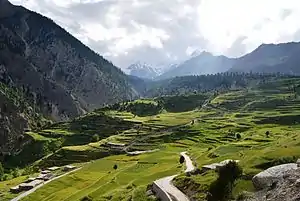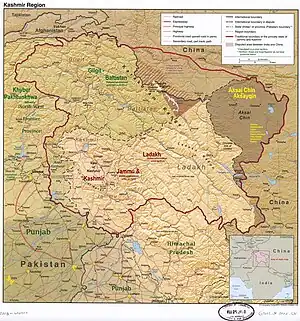Astore District
Astore District (Urdu: ضلع استور) is a district of Pakistan-administered Gilgit-Baltistan in the disputed Kashmir region.[1] It is one of the 14 districts of the Pakistani-administered territory of Gilgit−Baltistan.[2] Its administrative headquarters are located at Eidgah in the Astore Valley. The Astore District is bounded by Gilgit District to the north, Roundu District to the northeast, Skardu District to the east, Kharmang District to the southeast, Diamer District to the west, the Neelum District of Azad Jammu and Kashmir to the southwest, and the Bandipore District of Indian-administered Jammu and Kashmir to the south.


Astore District
ضلع استور | |
|---|---|
District of Gilgit−Baltistan administered by Pakistan.[1] | |
 Nanga Parbat seen from the Rama Valley near Astore District in August 2016 | |
Interactive map of Astore district | |
 A map showing Pakistani-administered Gilgit-Baltistan (shaded in sage green) in the disputed Kashmir region[1] | |
| Coordinates (Eidgah, Astore): 35°20′49″N 74°51′22″E | |
| Administering country | Pakistan |
| Territory | Gilgit-Baltistan |
| Division | Diamer |
| Headquarters | Eidgah |
| Government | |
| • Type | District Administration |
| • Deputy Commissioner | Muhammad Zulqanain Khan |
| • Superintendent of Police | N/A |
| • District Health Officer | N/A |
| Area | |
| • Total | 5,092 km2 (1,966 sq mi) |
| Population (1998) | |
| • Total | 71,666 |
| Number of tehsils | 2 |
Astore Valley

The Astore Valley has an area of 5,092 km2 and is at an altitude of 2,600 metres (8,500 ft). The valley has approximately 250 square kilometres (97 sq mi) of glacier cover.[3] The nearest glacier after entering the valley is the Harcho Glacier,[4] and the most accessible glacier is the Siachen Glacier.[5]
Accessibility
Eidgah is connected to Gilgit, which is well connected by air with Islamabad and by road with Peshawar, Swat, Islamabad-Rawalpindi, Chitral, and Skardu. There are two ways of access to Eidgah. The first is from Skardu via the Deosai Plateau 143 kilometres (89 mi),[6] but that route cannot be used from November to June due to heavy snowfall. The second way, year round, is from Gilgit via Jaglot 128 kilometres (80 mi).[7]
History
Around 1600, according to the Imperial Gazetteer of India:
Ghāzī Mukhpun, a Persian adventurer, is said to have married a princess of the Skārdu reigning family. The four sons born of this union became Rās of Astor, Kharmang, Rondu, and Skārdu, respectively, and from them are descended the families of the present chiefs of those places. The independence of Astor ceased with the Dogra conquest.[8]
References
- The application of the term "administered" to the various regions of Kashmir and a mention of the Kashmir dispute is supported by the tertiary sources (a) through (e), reflecting due weight in the coverage. Although "controlled" and "held" are also applied neutrally to the names of the disputants or to the regions administered by them, as evidenced in sources (h) through (i) below, "held" is also considered politicized usage, as is the term "occupied," (see (j) below).
(a) Kashmir, region Indian subcontinent, Encyclopaedia Britannica, retrieved 15 August 2019 (subscription required) Quote: "Kashmir, region of the northwestern Indian subcontinent ... has been the subject of dispute between India and Pakistan since the partition of the Indian subcontinent in 1947. The northern and western portions are administered by Pakistan and comprise three areas: Azad Kashmir, Gilgit, and Baltistan, the last two being part of a territory called the Northern Areas. Administered by India are the southern and southeastern portions, which constitute the state of Jammu and Kashmir but are slated to be split into two union territories.";
(b) Pletcher, Kenneth, Aksai Chin, Plateau Region, Asia, Encyclopaedia Britannica, retrieved 16 August 2019 (subscription required) Quote: "Aksai Chin, Chinese (Pinyin) Aksayqin, portion of the Kashmir region, at the northernmost extent of the Indian subcontinent in south-central Asia. It constitutes nearly all the territory of the Chinese-administered sector of Kashmir that is claimed by India to be part of the Ladakh area of Jammu and Kashmir state.";
(c) "Kashmir", Encyclopedia Americana, Scholastic Library Publishing, 2006, p. 328, ISBN 978-0-7172-0139-6 C. E Bosworth, University of Manchester Quote: "KASHMIR, kash'mer, the northernmost region of the Indian subcontinent, administered partlv by India, partly by Pakistan, and partly by China. The region has been the subject of a bitter dispute between India and Pakistan since they became independent in 1947";
(d) Osmańczyk, Edmund Jan (2003), Encyclopedia of the United Nations and International Agreements: G to M, Taylor & Francis, pp. 1191–, ISBN 978-0-415-93922-5 Quote: "Jammu and Kashmir: Territory in northwestern India, subject to a dispute between India and Pakistan. It has borders with Pakistan and China."
(e) Talbot, Ian (2016), A History of Modern South Asia: Politics, States, Diasporas, Yale University Press, pp. 28–29, ISBN 978-0-300-19694-8 Quote: "We move from a disputed international border to a dotted line on the map that represents a military border not recognized in international law. The line of control separates the Indian and Pakistani administered areas of the former Princely State of Jammu and Kashmir.";
(f) Skutsch, Carl (2015) [2007], "China: Border War with India, 1962", in Ciment, James (ed.), Encyclopedia of Conflicts Since World War II (2nd ed.), London and New York: Routledge, p. 573, ISBN 978-0-7656-8005-1,The situation between the two nations was complicated by the 1957–1959 uprising by Tibetans against Chinese rule. Refugees poured across the Indian border, and the Indian public was outraged. Any compromise with China on the border issue became impossible. Similarly, China was offended that India had given political asylum to the Dalai Lama when he fled across the border in March 1959. In late 1959, there were shots fired between border patrols operating along both the ill-defined McMahon Line and in the Aksai Chin.
(g) Clary, Christopher, The Difficult Politics of Peace: Rivalry in Modern South Asia, Oxford and New York: Oxford University Press, p. 109, ISBN 9780197638408,Territorial Dispute: The situation along the Sino-Indian frontier continued to worsen. In late July (1959), an Indian reconnaissance patrol was blocked, "apprehended," and eventually expelled after three weeks in custody at the hands of a larger Chinese force near Khurnak Fort in Aksai Chin. ... Circumstances worsened further in October 1959, when a major class at Kongka Pass in eastern Ladakh led to nine dead and ten captured Indian border personnel, making it by far the most serious Sino-Indian class since India's independence.
(h) Bose, Sumantra (2009), Kashmir: Roots of Conflict, Paths to Peace, Harvard University Press, pp. 294, 291, 293, ISBN 978-0-674-02855-5 Quote: "J&K: Jammu and Kashmir. The former princely state that is the subject of the Kashmir dispute. Besides IJK (Indian-controlled Jammu and Kashmir. The larger and more populous part of the former princely state. It has a population of slightly over 10 million, and comprises three regions: Kashmir Valley, Jammu, and Ladakh.) and AJK ('Azad" (Free) Jammu and Kashmir. The more populous part of Pakistani-controlled J&K, with a population of approximately 2.5 million.), it includes the sparsely populated "Northern Areas" of Gilgit and Baltistan, remote mountainous regions which are directly administered, unlike AJK, by the Pakistani central authorities, and some high-altitude uninhabitable tracts under Chinese control."
(i) Fisher, Michael H. (2018), An Environmental History of India: From Earliest Times to the Twenty-First Century, Cambridge University Press, p. 166, ISBN 978-1-107-11162-2 Quote: "Kashmir’s identity remains hotly disputed with a UN-supervised 'Line of Control' still separating Pakistani-held Azad ('Free') Kashmir from Indian-held Kashmir.";
(j) Snedden, Christopher (2015), Understanding Kashmir and Kashmiris, Oxford University Press, p. 10, ISBN 978-1-84904-621-3 Quote:"Some politicised terms also are used to describe parts of J&K. These terms include the words 'occupied' and 'held'." - "GB notifies four more districts, total number of districts now 14". Pakistan Today.
- Sher Muhammad, Lide Tian, Asif Khan, "Early twenty-first century glacier mass losses in the Indus Basin constrained by density assumptions", Journal of Hydrology, Volume 574, 2019, pages 467–475
- Muhammad, S., Tian, L., & Nüsser, M. (2019). "No significant mass loss in the glaciers of Astore Basin (North-Western Himalaya), between 1999 and 2016". Journal of Glaciology, 65(250), 270–278. doi:10.1017/jog.2019.5
- Muhammad, S. and Tian, L. (2016) Changes in the ablation zones of glaciers in the western Himalaya and the Karakoram between 1972 and 2015, Remote Sensing of Environment. Elsevier Inc., 187, pp. 505–512. doi: 10.1016/j.rse.2016.10.034.
- "Distance from Skardu via Deosai Plains". Google Maps. Retrieved 4 August 2019.
- "Distance from Gilgit via Jaglot". Google Maps. Retrieved 4 August 2019.
- "Gilgit" - Imperial Gazetteer of India, v. 12, p. 239 According to the Imperial Gazetteer, which was compiled in the first decade of the twentieth century, the marriage took place over three hundred years previously.